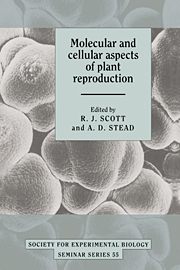Book contents
- Frontmatter
- Contents
- List of Contributors
- Introduction: ‘Where do we go from here?’
- Molecular control of floral organogenesis and plant reproduction in Petunia hybrida
- Control of floral morphogenesis in cauliflower (Brassica oleracea L. var. botrytis): the role of homeotic genes
- Isolation and properties of mutants of Arabidopsis thaliana with reduced sensitivity to short days
- Asexual mutants in Melandrium album (Silene alba): tools in cDNA cloning and analysis of an X/Y chromosome system in plants
- Pollen exine – the sporopollenin enigma and the physics of pattern
- The diversity and regulation of gene expression in the pathway of male gametophyte development
- Characterisation of Arabidopsis thaliana anther-specific gene which shares sequence similarity with β-1,3-glucanases
- Ovule cDNA clones of Petunia hybrida encoding proteins homologous to MAP and shaggy/zeste-white 3 protein kinases
- Towards the elucidation of the mechanisms of pollen tube inhibition during the self-incompatibility response in Papaver rhoeas
- Intracellular movement and pollen physiology: progress and prospects
- Organisation and functions of cell surface molecules on gametes of the brown algae Fucus
- Strategies of flower senescence – a review
- The physiology of petal senescence which is not initiated by ethylene
- Molecular biology of flower senescence in carnation
- Ethylene sensitivity and flower senescence
- Ethylene biosynthetic genes and inter-organ signalling during flower senescence
- Index
Control of floral morphogenesis in cauliflower (Brassica oleracea L. var. botrytis): the role of homeotic genes
Published online by Cambridge University Press: 04 August 2010
- Frontmatter
- Contents
- List of Contributors
- Introduction: ‘Where do we go from here?’
- Molecular control of floral organogenesis and plant reproduction in Petunia hybrida
- Control of floral morphogenesis in cauliflower (Brassica oleracea L. var. botrytis): the role of homeotic genes
- Isolation and properties of mutants of Arabidopsis thaliana with reduced sensitivity to short days
- Asexual mutants in Melandrium album (Silene alba): tools in cDNA cloning and analysis of an X/Y chromosome system in plants
- Pollen exine – the sporopollenin enigma and the physics of pattern
- The diversity and regulation of gene expression in the pathway of male gametophyte development
- Characterisation of Arabidopsis thaliana anther-specific gene which shares sequence similarity with β-1,3-glucanases
- Ovule cDNA clones of Petunia hybrida encoding proteins homologous to MAP and shaggy/zeste-white 3 protein kinases
- Towards the elucidation of the mechanisms of pollen tube inhibition during the self-incompatibility response in Papaver rhoeas
- Intracellular movement and pollen physiology: progress and prospects
- Organisation and functions of cell surface molecules on gametes of the brown algae Fucus
- Strategies of flower senescence – a review
- The physiology of petal senescence which is not initiated by ethylene
- Molecular biology of flower senescence in carnation
- Ethylene sensitivity and flower senescence
- Ethylene biosynthetic genes and inter-organ signalling during flower senescence
- Index
Summary
Introduction
Cauliflower (Brassica oleracea L. var. botrytis) is a member of the genus Brassica in the family Brassicaceae. It is a major economic crop which is marketed as a large, white, pre-floral, compact curd. The cauliflower curd is, however, susceptible to a number of morphological defects which can seriously reduce its commercial value (King, 1990). The genetic determinants that control floral meristem development and flower morphogenesis in cauliflower have not been approached at the molecular level until recently. Medford, Elmer and Klee (1991) have now isolated and partially characterised a number of meristematic genes expressed in the immature cauliflower curd. In addition, Anthony, James and Jordan (1993) have isolated a homologue of the Antirrhinum flo gene (Coen et al., 1990) that is thought to be involved in regulating floral initiation.
In this review, we will briefly describe the morphology and physiology of the cauliflower, with particular emphasis on floral development. In addition, we will describe the isolation of genes involved in floral initiation and discuss how these genes may interact to control cauliflower morphology.
Morphology and physiology of cauliflower floral development
Five stages of development have been recognised between vegetative growth and flowering in cauliflower (Margara & David, 1978): 1. The vegetative stage in which the small pointed shoot apex is surrounded by leaf primordia. These arise acropetally in a spiral succession and axillary branches do not develop; 2. Initiation of inflorescence results in precocious formation of axillary buds at the apex to form clusters of meristems and bracts; 3.
- Type
- Chapter
- Information
- Molecular and Cellular Aspects of Plant Reproduction , pp. 17 - 30Publisher: Cambridge University PressPrint publication year: 1994
- 2
- Cited by

